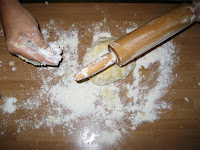My mother was French, you see and the French on the whole prefer fruit or cheese for dessert. BUT they do like a good tart!
OK. Here is Claudia’s basic recipe for short pastry:
• 225g/8oz flour
• 125g/4oz butter (at room temperature)
• ice cold refrigerated water
• a 23-25cm/9-10in flan tin (pie dish)
(If you have a larger-sized tin, simply increase the measurements in proportion to each other ie 10oz flour to 5oz butter, 12 to 6 etc).
Pre-heat your oven to 180/350 degs.
Method
• Measure out the flour and put it in a bowl. Add the butter in small pieces.
 • Using your fingers –just your right hand is enough- mix the butter into the flour but don’t go too far otherwise it turns into crumbs. (Take rings off!) Don’t worry if there are lumps as these will be integrated into the pastry in a minute.
• Using your fingers –just your right hand is enough- mix the butter into the flour but don’t go too far otherwise it turns into crumbs. (Take rings off!) Don’t worry if there are lumps as these will be integrated into the pastry in a minute.• When it forms a ball, take it out of the bowl and lay it on the counter (cool marble is ideal!) which you have liberally sprinkled with flour. Now knead your ball. This feels great! It should be smooth and flexible at this stage. Some people recommend putting it in the fridge in a plastic bag for 30 minutes just to rest it but I never seem to do that.
• And now take your trusty rolling pin, flour it as well as putting a spoonful of flour on top of your pastry, and roll away! Roll it in all directions. Turn it over and roll. At this point, the shape is not that important. Now comes my mother’s trick: take your butter which has become nice and soft as it has been out of the fridge all this time, and with a knife, spread it all over your circle of pastry. This makes it ‘shorter’ ie you are on the way to milles feuilles! Just kidding, but it does add that melt-in-your-mouth touch after baking.
• Then from the top, fold the pastry over, then from the bottom and finally the sides, so you have a nice little packet in front of you. Turn it over, again sprinkle with a little flour so it doesn’t stick to your rolling pin, and roll it out. Don’t be scared of it. Go for it, left, right, up and down. This time try to get it to the shape of your tin. If the consistency is right and you have made enough for the size of your tin, this is a breeze. Fold it over gently to transfer to the tin or dish. You can do this easily with your hands, you don’t need a spatula or anything.
With a sharp knife, go round the edges cutting off the excess. I sometimes make a pattern with a fork round the edge or I use this nifty little device that I have that looks like a trick cyclist’s wheel and roll it round the edge if it is thick enough, to make it look nice. I always prick the bottom all over with a fork to stop the pastry rising. I never do that business with greaseproof paper and pulses as I don’t see the need for it.
I use the trimmings to make little cutout shapes to decorate the tart with. For these I use my old childhood cookie cutters so we have little rabbits, ducks and something that looks like Rupert Bear! But of course I can be more serious too and also have hearts and flowers to embellish my tarts. If I’m feeling creative, I ‘draw’ stems and leaves with a sharp knife and then make my own design.
Another good way of using up the extra bits that my friend Lesley told me about is to roll them out, sprinkle with granulated sugar, roll it in and then using cookie cutters, make little biscuits! She says they are called sables ie from the French, sandy! These cook quickly in your pre-heated oven at 180 degs for about 10 mins.
Tips:
• I may not subscribe to some of the usual rules associated with pastry-making but there are indeed some that hold true. One is that pastry does not like hot weather and indeed it doesn’t! My pastry the other day, for example. It was 38 degrees outside and the pastry magically felt it. It was impossible to roll out smoothly so I had to patch it up a bit to make it fit the tins. So you see, there are always pitfalls! That’s why a cold marble surface is ideal.
• The other tip is that I always place my tin on a baking sheet that has been in the oven while heating up. This is to make sure the base of the pastry case cooks through. How many times have you eaten stodgy quiche?
• Pastry cases freeze very well. Make sure you wrap them in foil or clingfilm otherwise they go all hard and take on an attractive greyish colour!
 |
| Voila! |












No comments:
Post a Comment